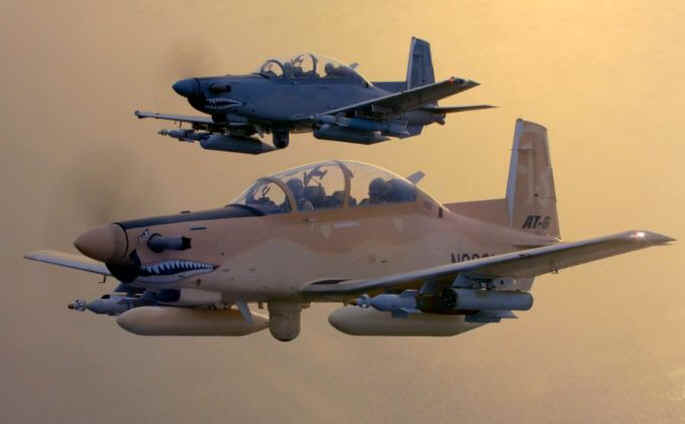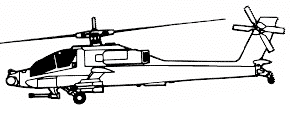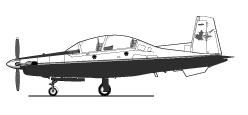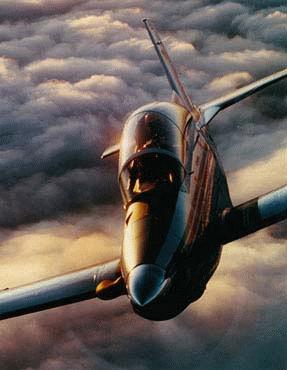The US military must form squadrons of its T-6 Texan II trainers to support combat operations. This aircraft is fully aerobatic and features a pressurized cockpit with an anti-G system, ejection seats, and an advanced avionics package with sunlight-readable liquid crystal displays. Its narrow fuselage and large canopy allow for excellent observation, especially since the rear seat is elevated. Moreover, this modern aircraft has a top speed of 320 mph and is currently in service and in production for $6 million each. The training and parts pipeline is already in place, and every new pilot in the US Air Force, Navy and Marines is already qualified to fly them, although they should attend an observation school to learn how to properly employ them in combat.
The T-6 is a single-engine, stepped tandem, two-seat primary trainer aircraft that entered service in 1998. Its Pratt Whitney PT6A-68 engine is flat rated at 1100 shaft HP and provides excellent thrust-to-weight ratio for an initial rate of climb of more than 4,500 fpm and outstanding short field capability. The T-6A combines features typical of a primary trainer with the very low fuel consumption and overall economy of a turboprop, while simultaneously providing 50 percent more overall thrust than its predecessor. A decade ago, the Marine Corps conducted exercises employing the older model Texans as spotter aircraft. Despite all the high-tech devices available, Marines learned the best aerial intelligence was provided by the backseater in the Texans using high-powered binoculars. These exercises proved their value, but the fighter jet Generals that dominate Marine Corps aviation dismissed the idea of reestablishing VMO "observation" squadrons.

Raytheon developed a kit to optimize the Texan's performance in combat environments, converting them as AT-6C light attack aircraft (pictured). OV-6C Texan "Ranger" is a better designation; "O" for Observation and "V" for its short take-off and landing ability. The C version has a weapons control computer and six wing hard points for mounting bombs, rocket pods, or machine guns. It can also employ laser-guided Hellfire missiles and drop 500lb laser guided bombs.
However, a Ranger should not become an attack aircraft, but a much needed observation and support platform that must include appropriate communications and surveillance equipment. This inexpensive and nimble two-seat aircraft provides a clear view where a highly trained fire support coordinator can ensure safe and effective fires on the enemy below. Airborne fire support today is attempted by partially trained pilots from slow helicopters, F/A-18D fast FACs, or single-seat OA-10s where a pilot is expected to fly the aircraft while coordinating strikes. Both jets will soon be replaced by single-seat F-35s that cannot perform this role.
Despite America's overwhelming technical superiority and air dominance in recent conflicts, dozens of casualties resulted from battlefield confusion. This G2mil article about the: Ambush at Takur Ghar in Afghanistan, quotes a Washington Post article: "At headquarters, commanders tried to notify the Rangers that the SEALs had retreated from the ridgetop and to direct the helicopters to another landing zone further down the mountain. Due to intermittently functioning aircraft communications equipment, the Rangers and aircrew never received the instructions, according to the official review. Communication problems also plagued headquarters attempts to determine the true condition of the SEAL team and its exact location."
During the 2003 US invasion of Iraq, units became intermingled as Iraqi irregulars attacked at random causing confusion. Several US soldiers were captured and a US Marine infantry company was forced to retreat after an ill planned attack, while an American A-10 strafed them. In these cases and dozens of smaller engagements, an OV-6C Ranger overhead could have saved the day. The value of Rangers can be envisioned while watching the popular movie "Sole Survivor" based on a true story "Operation Redwing" in Afghanistan. A Navy SEAL team was unable to communicate with its headquarters despite the latest high-tech gear, to include a satphone. Jet air support was not readily available from big, distant airbases and the rescue force lost a big Chinook helicopter while landing near enemy forces. If Ranger aircraft were available, they would have saved the day.
OV-6C Rangers can operate in short take-off environments like forward airfields, roads, or large amphibious ships. They are ideal for accommodating senior officer visits to the frontlines, which often ties up much needed helicopters. A Ranger pilot can provide a General with a faster, longer, and safer tour of the frontlines. Rangers are an economical way to quickly deliver small emergency cargo, like: spare parts, software, battle plans, and specialists. Compared to helicopters and jet attack aircraft, the Ranger is much quieter, one-tenth the cost, and half their length, which makes them harder to see and hit. It is far more practical to risk a $6 million Ranger for close reconnaissance than a $100 million F-35 or a slow helicopter without ejection seats. As a result, a Ranger should lead all large helicopter formations hoping to draw fire from enemy gunners.



AH-64 Apache (58.2 feet) T-6 Texan II (33.5 feet) FA-18D Hornet (56 feet)
Since the retirement of the OV-10s, the Army and Marines have used expensive attack helicopters for reconnaissance. An inexpensive OV-6C Ranger has twice their range, twice their speed, and ejection seats. The Army's primary reconnaissance helicopter, the OH-58 Kiowa, is small and quiet, but with a cruise speed of just 80 knots it is far too slow to keep up with transports and attack helos. The Kiowa's range and endurance is only one-fifth that of a Ranger, which can also fly three times higher to avoid medium-range AAA fires. On rapidly moving battlefields, ground forces can advance beyond the Kiowa's range the first day of an offensive. Even during slow moving operations, the Kiowa lacks the endurance to remain on station for hours to provide continual support for ground forces, which is why the Army plans to retire them.
OV-6C Ranger missions
1. Forward Air Control - The US military had many cases of fratricide during the 2003 Iraq invasion because fast moving jet pilots assumed they understood the situation on the ground. This was less a problem in Vietnam when OV-10 Broncos were employed as spotters. The Bronco was retired leaving a major gap in close air support that the faster Ranger can fill. This will free larger, expensive jets to use their speed and payload to deliver munitions.
The US Marine Corps lost a couple OV-10s over Iraq during the 1991 war when they were employed in the deep reconnaissance role in a mid-threat environment. Jet pilot Generals claimed this proved they were too slow and led to their removal from service. Many Marines were shocked because OV-10s has twice the speed and range of helicopters. However, the Ranger has a top speed of 320 mph (50 mph faster than the OV-10) and four times more range -- up to 900 miles.
In high-threat Anti-Aircraft Artillery (AAA) environments, an airborne Ranger crew does not need to actually see targets. It can remain low over friendly forces as a liaison who knows the location of every ground unit, and sometimes pops up to take a quick look. When jets arrive they will see the Ranger right away who can literally point them in the right direction. The problem with ground FACs is that pilots feel uncomfortable because they can't see who they are talking to so they are unsure of their exact position and orientation.
Despite major advances technology and training, American
aircraft frequently kill friendly ground troops by accident. In June 2014, a
B-1B bomber dropped a bomb killing five American soldiers due to confusion.
This occurred in a daytime, clear weather, environment with no enemy
anti-aircraft weaponry. An
airborne Ranger could have turned his aircraft and told them: "the bad guys are three kilometers directly to my front." He may even pop
up to draw fire so the jets can see the enemy guns and attack them. Or just
attack themselves. One must ask why a big, fast, ultra-expensive B-1 bomber was
tasked with bombing a few insurgents?
2. Artillery Spotting - Tiny US Army spotting aircraft were
essential for artillery units fighting in Europe during World War II.
However, the Army has no spotting aircraft today so an artillery battery is
unable to adjust fires unless a forward observer is on the ground near the
target and able to communicate with the firing battery. A Kiowa scout
helo can spot artillery fire, but that is a very slow platform with little endurance. A Ranger can call
in artillery fires on enemy forces miles ahead of friendly ground forces using
its speed or high-altitude capability to avoid ground fire.
3. Frontline Reconnaissance - Rangers are vulnerable in high-threat AAA, although they are much smaller and faster than attack helicopters. The solution is for pilots to use their judgment and operate like attack helicopters. If the AAA threat is high, they will fly low and avoid enemy held areas. They will remain just behind advancing forces and pop up occasionally for a quick look. If enemy heavy machine guns or AAA shoot at them, it exposes their positions to attack by ground forces.
Despite the emphasis on high-tech warfare, almost all fighting by US ground troops occurs against enemies with little anti-aircraft weaponry. In those situations, the best surveillance platform is a small, circling two-seat propeller aircraft. A spotter with high-power binoculars and radios can remain on station for hours, flying high enough where he cannot be seen or heard. Unlike UAVs, this spotter can see in all directions, and can hear explosions so he knows if someone is shooting at him. Shooting down enemy UAVs is an ideal role for Rangers and unlike UAVs, their guidance cannot be jammed, a rarely mentioned shortfall of UAVs.
4. Long-range Reconnaissance - No platform can provide long-range reconnaissance better and less costly than a small single-engine propeller airplane. Naval forces need these to patrol ship lanes to intercept small enemy boats full of commandos or surveillance gear and to surprise submarines operating in shallow waters. Aircraft can also patrol main land supply routes to surprise minelayers. If they see something odd, they can turn and make numerous passes, and even open fire. This is far better than an expensive drone sending pictures to headquarters.
The great book "Killing Pablo", about the hunt for drug lord Pablo Escobar in Colombia, mentions another advantage of small propeller aircraft. The US Army employed small RC-12s to locate cell phone transmissions and observe suspect areas. In Third World nations, small propeller aircraft are common and attract no notice, whereas a jet aircraft or a helicopter flying overhead is odd and attracts immediate attention.
5. Search and Rescue - This mission favors long-range slow-moving aircraft. However, it may be risky to employ Rangers in high threat environments. Yet the US military now operates in mostly benign environments where expensive helicopters frequently conduct hours of road and border reconnaissance. Rangers are better suited for such operations since they are quieter, faster, and much cheaper to operate.
 6. Radio Relay - Small units sometimes lose radio contact because of
hills, mountains, buildings, or a lack of batteries. Sophisticated enemies
may jam radio or GPS frequencies leaving ground units confused. With a Ranger overhead, they can ask for
message relay or directions. In some cases, a Ranger will spot friendly
units moving down the wrong road or heading toward an ambush, so the guys in the
sky will help.
6. Radio Relay - Small units sometimes lose radio contact because of
hills, mountains, buildings, or a lack of batteries. Sophisticated enemies
may jam radio or GPS frequencies leaving ground units confused. With a Ranger overhead, they can ask for
message relay or directions. In some cases, a Ranger will spot friendly
units moving down the wrong road or heading toward an ambush, so the guys in the
sky will help.
7. Emergency Close Air Support (CAS) - This mission is listed last in hope of avoiding the inevitable digression into the best platform for CAS. Many soldiers who like the idea of a slow and low flying A-1 Skyraider used in Vietnam will discover the small Ranger lacks payload capacity and argue for something larger. Jet fighter pilots will use this as an excuse to evaluate and develop alternatives, resulting in a never-ending study to shelve this idea. This is why promoting an AV-6C Ranger is a bad idea; "A" is a designation for attack aircraft.
The best answer is to allow each commander to use his judgment based on the enemy threat and mission at hand. There may be situations in remote regions where no large airfields exist to operate jet attack aircraft, so OV-6Cs may be the only CAS option. And of course if US ground forces face probable defeat in a major battle, OV-6Cs will be thrown into the fight. While they carry little payload, strafing Rangers can frighten an advancing enemy and force him to redirect his firepower upward. Some argue that turboprops are too slow for the modern battlefield, even though they are twice as fast as more expensive attack helicopters that lack ejection seats.
Employ Rangers Now
Despite the obvious value of immediately forming Ranger squadrons, opposition will arise from those who favor a larger platform, or one from their company or district. Others will see the Ranger as a threat to their program, especially those touting expensive and far less capable UAVs. They will urge "studies" and "competition" to kill this idea. Many argue that the Super Tacano from Brazil is superior. That may be true, but the T-6 training and logistics pipeline is well established and is made in the USA.
The OV-6C research, development, testing, and production timetable is zero. Various high-tech targeting and surveillance systems may be added, so long as weight and cost increases are moderate. If the US military adopts inexpensive OV-6Cs for combat use, this will ensure numerous orders from other nations that will create American jobs.
The US Marine Corps and US Army need support from OV-6C Ranger squadrons. Since the Marines plan to replace their two-seat F/A-18Ds with single-seat F-35s, they need a new airborne FAC platform. The Air Force recently announced the retirement of all OA-10s with no mention of who will perform the airborne FAC mission. The Army and Air Force must agree on who will fund and man Ranger squadrons. The Army is prohibited from operating fixed-wing aircraft, although exceptions have been made for VIP aircraft and small signal intelligence aircraft. Unless the Air Force wishes to fund and man Ranger squadrons, they should agree to allow the Army to operate any rotary aircraft; no jets of course. Once the OV-6C squadrons are established, the debate can commence to select and develop a superior replacement aircraft, something that takes the US military at least ten years. If that occurs, the OV-6Cs can revert to T-6s and go to training squadrons. Meanwhile, OV-6C Rangers can immediately fill a critical gap.
©2015 www.G2mil.com
May 2017 Update
US Marine advocates an AT-6.